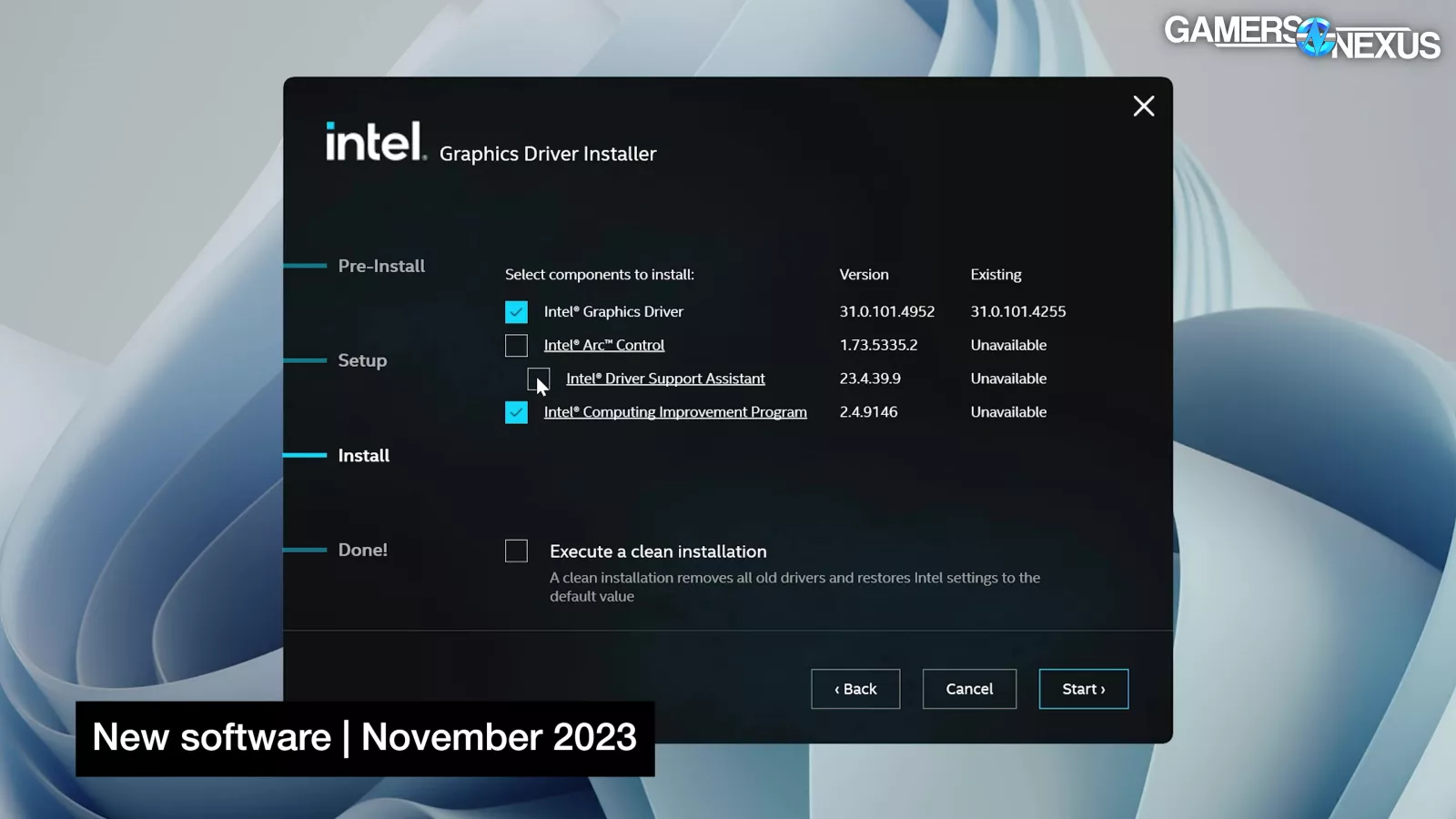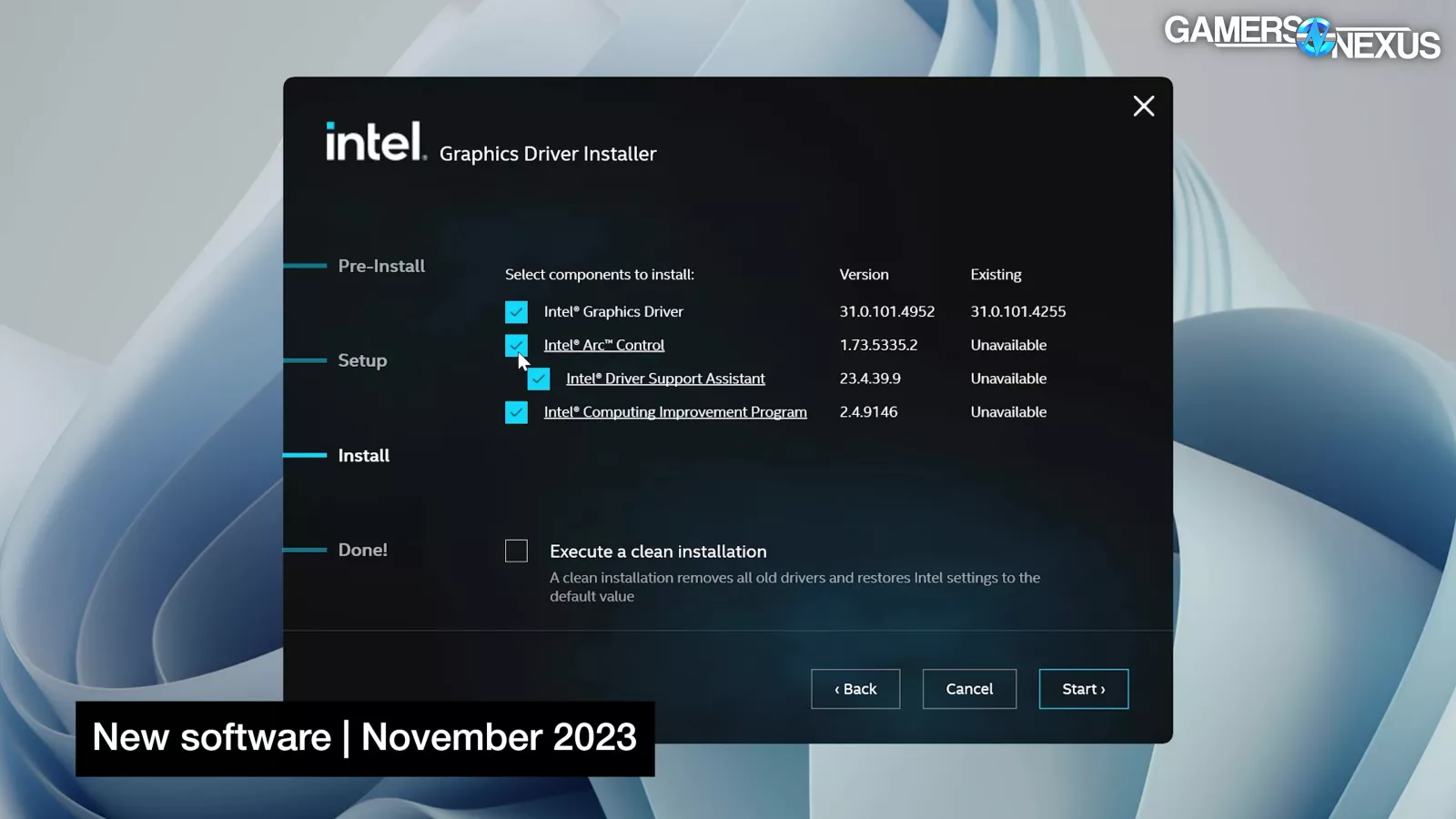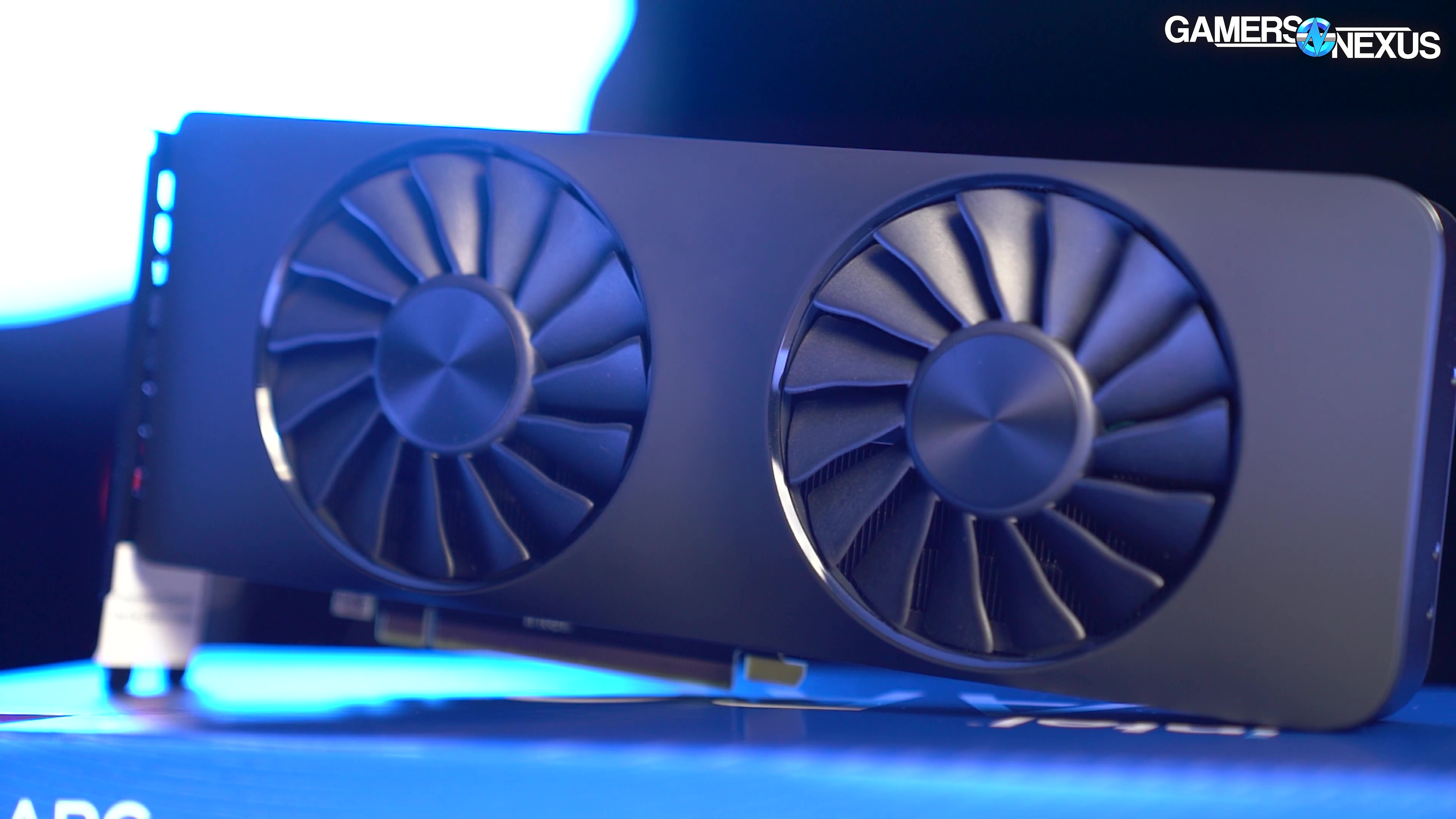
Intel has made many noticeable software improvements to its Arc GPUs one year after launch
The Highlights
- Intel has been forthcoming about the various issues it needs to overcome
- Intel Arc GPUs still struggle in certain Dx9 and Dx11 games compared to the competition
- Despite the improvements and bug fixes, Intel still has its work cut out to make Arc GPUs more compelling to the masses
- Original MSRP: $290 - $350
- Release Date: October 12, 2022
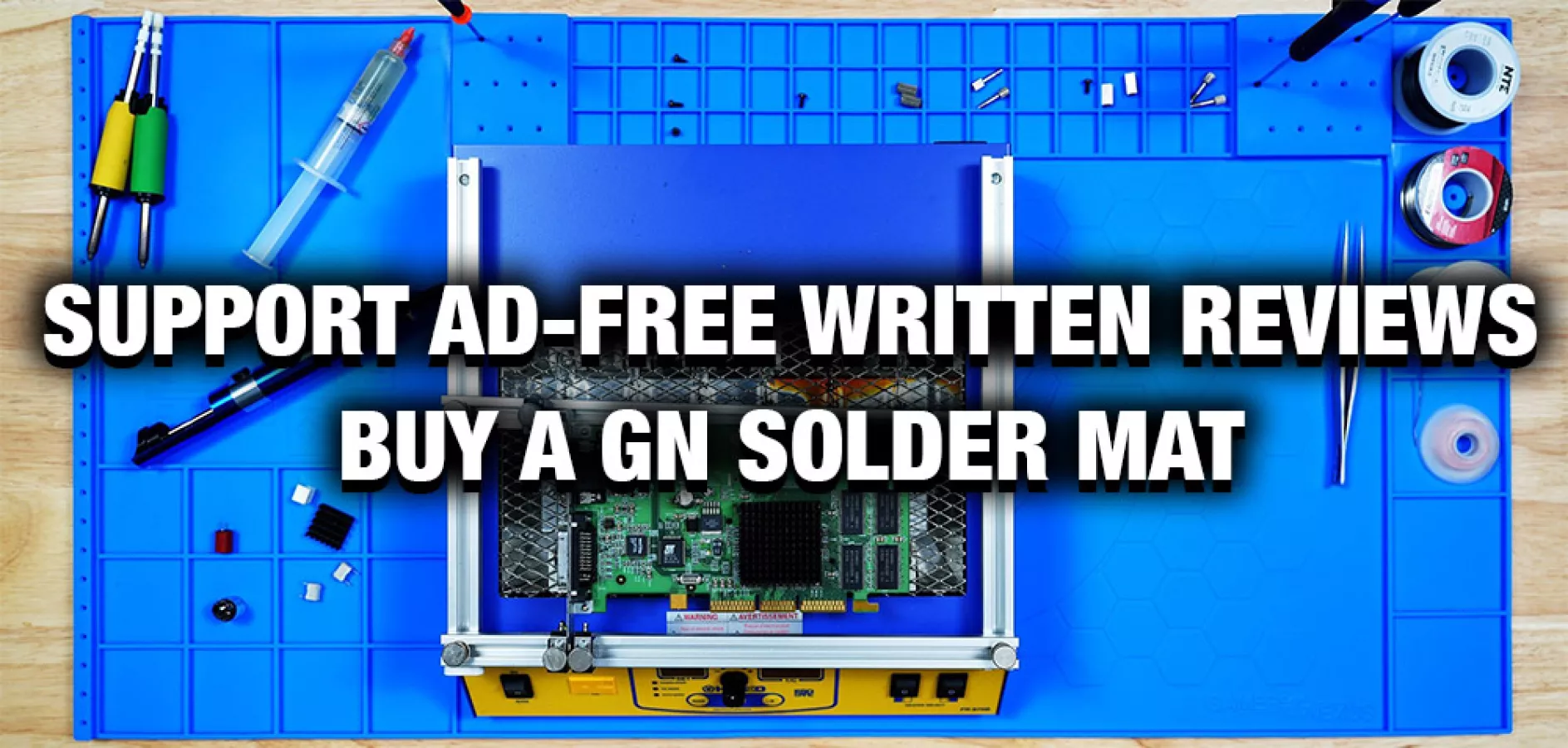
It’s been a little over a year since Intel Arc discrete GPUs launched, and the launch was... bad.
And to Intel’s credit, it acknowledged that and even named us in a blog post where it promised to fix its issues. But a lot has changed, so we’re revisiting our punch list of driver issues to see how much our recommendation has changed with the improvements.
There was a point in time, in the midst of pandemic-related shortages and with everyone trapped indoors playing video games, when Intel was primed to eat NVIDIA and AMD's lunch. All Arc had to do was exist and cost less than $1,000. It missed the mark on launch and was late, but did manage to land below $1,000 -- far below it, and that's the biggest advantage Intel has held.
Credits
Testing, Host, Writing
Steve Burke
Testing, Writing, Research
Patrick Lathan
Video Editing
Vialii Makhnovets
Writing, Web Editing
Jimmy Thang
After Arc's official August 2021 announcement, delays followed, as did several launches that seemed designed to satisfy legal language. Arc technically launched on the next-to-last day of Q1 2022, but only in laptops, and the first discrete gaming card (the A380) launched at the end of Q2, but only in China. The A750 and A770, the "real" cards everyone was waiting for, showed up in Q4 2022. By that point, Intel was allegedly offering CPUs in lieu of GPUs as prizes for the Xe-HPG scavenger hunt. That's not to mention the half-baked Xe DG1 that preceded all of this back in November 2020.
All that is to say that Arc had more time in the oven than anyone could have predicted, and yet judging by our early coverage of the A380's drivers, it needed every minute.
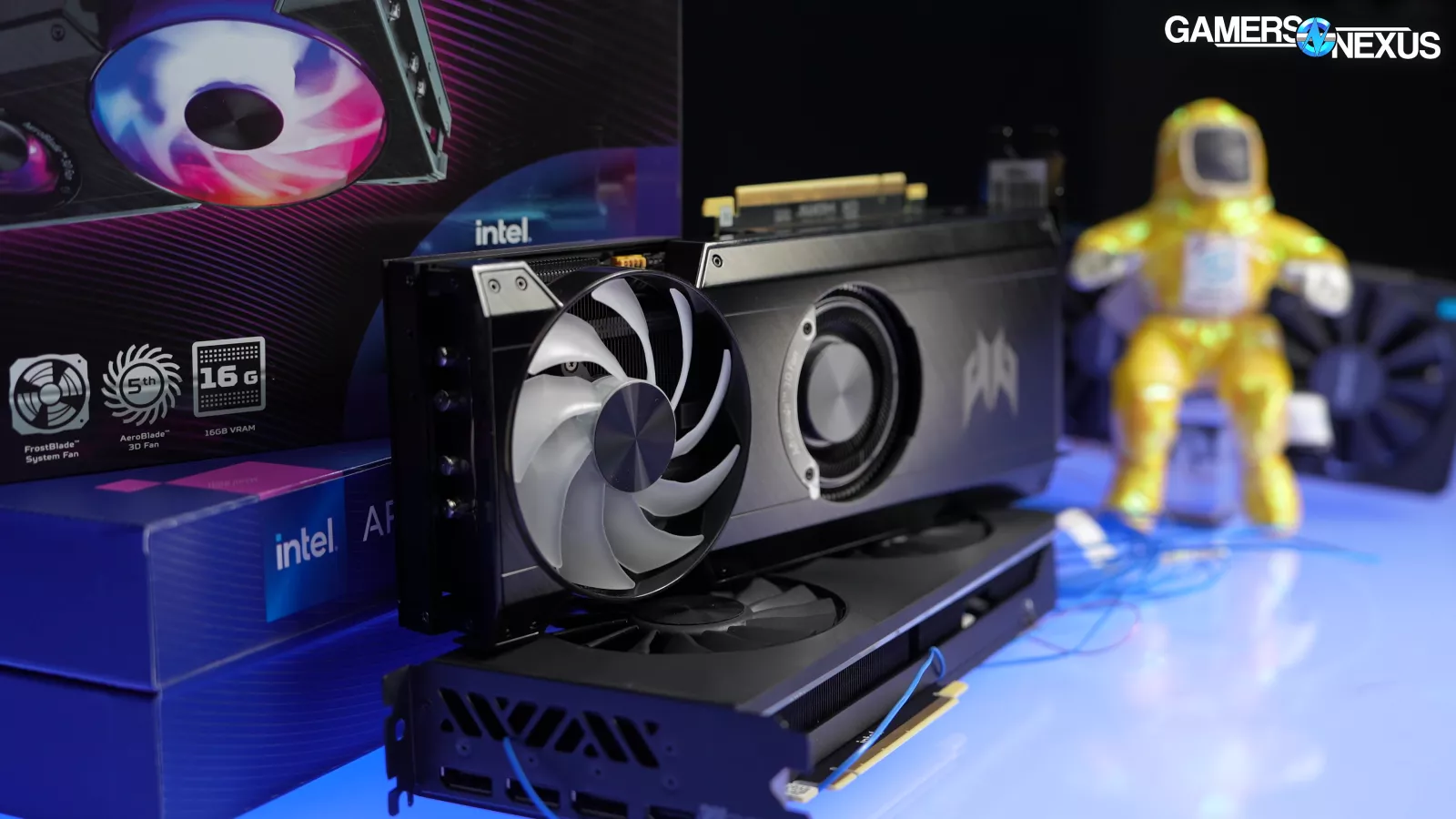
And now it’s time to see if it’s ready for prime time. Again.
The driver and Arc Control software were plagued by bugs, many of which were minor, but the combined experience made testing hell. Intel jumped in at the deepest possible end: yes, it had been shipping IGPs and accompanying software for years, but it hadn't shipped a consumer AIC GPU since a halfhearted attempt in 1998. And we covered that story arc in our 3dfx Voodoo revisit and historical retrospective. You should check it out.
In spite of this, Intel has been trying to immediately replicate every NVIDIA and AMD feature: first-party recording and streaming functions, XeSS, ray tracing, overlays, performance controls, and integer scaling, to name a random handful. This shotgun approach to software features when the hardware itself is still brand new ended up spreading Intel’s focus in too many directions, leading in a lot of half-working things.
As a result of that A380 coverage, Intel immediately began posting updates, and noted in its August 2022 blog that it had "filed 43 issues with our engineering team from a review of the A380 by GamersNexus" and "corrected 4 of those issues by the end of July." We checked back in to report on that post, and then again at the beginning of this year to check for performance improvements. But the biggest area we’ve seen improvement is simply in performance. DirectX 9 got a big overhaul, as did Dx11. We’ll revisit that at the end here.
Intel's Challenge
We won't re-explain all the many challenges that any GPU manufacturer would face trying to enter this market, but the important ones are software and drivers. Making the hardware is difficult enough. Intel did pretty well there; they made hardware that, when the software, the drivers, and the games all mesh together and work, actually runs competitively. With recent price drops for things like the Intel Arc A750, where we've seen them as low as $190, just $10 over the new A580, the A750 genuinely is a very strong competitor in the games where it runs well.
All of our tests of Arc have been caveated with the note that enthusiasts should be the ones buying it: people who have the troubleshooting experience and the patience to deal with the card, and ideally, have a backup GPU from Nvidia or AMD. That's been the line that we've been drawing in our recommendations, and Intel needs to fix that. Part of fixing that is improving a lot of the bugs it's had and usability issues. Some of this will be ongoing, though.
Let’s start with the problems.
The Problems with Intel Arc
We won't claim to have found every bug, and we haven't written down every single known issue in Intel's patch notes, but we do have a list of things that we've personally encountered.
Intel Arc Unfixed Problems
Smooth Sync and Speed Sync
Starting with unfixed problems: We discussed the visual artifacting bugs with Smooth Sync back when the A380 launched, but our recap of what the feature is supposed to do was cut for time. Here's a summary: Smooth Sync and Speed Sync are both "tearing mitigation modes" buried in the Frame Delivery submenu of Arc Control. As for the other options, "Application Choice" respects in-game settings, VSync delivers frames in sync with the display refresh rate, and Smart VSync "automatically enables VSync when the application's render rate exceeds the displays refresh rate and disables VSync when the render rate falls below the displays refresh rate." Other than "Application Choice," each of these driver-level settings requires VSync to be turned off in-game in order to take effect.
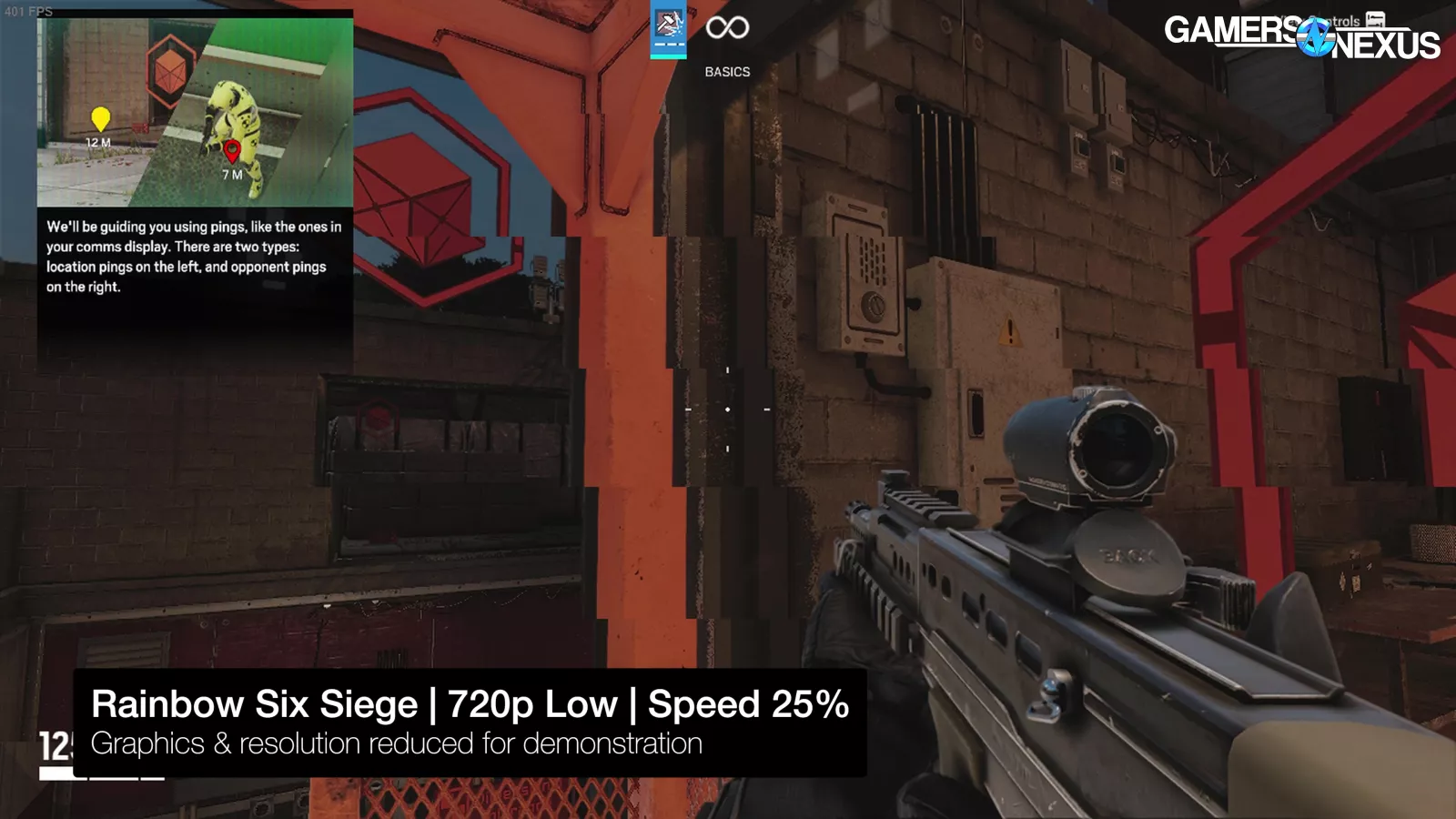
All of these options are designed to mitigate tearing, which happens when the GPU delivers frames out of sync with the display, primarily on displays without variable refresh capability (FreeSync, G-Sync, Adaptive Sync, VRR). VSync delays frame delivery to eliminate tears. Speed Sync allows the game engine to run ahead uncapped, then delivers the newest whole frame to eliminate tears (but it may lead to perceived stuttering). Smooth Sync allows tearing, but it dithers tears over exactly 32 scanlines. This is handled by "a hardware block inside the display engine" and had no measurable performance impact in our testing.
The problem we noted back in August 2022 was that enabling Smooth Sync caused serious artifacting in several of the games we benched, specifically non-DX12 games like Total War: Three Kingdoms, Tom Clancy's Rainbow Six Siege, and Grand Theft Auto V. Intel's blog post later that month stated that "we corrected 21 UI issues in our driver release on August 19th, and it also includes [...] fixes on SmoothSync corruptions," and the (no longer publicly hosted) patch notes for that driver release lists "Enabling 'Smooth Sync' may exhibit display corruption in certain game titles" under the "FIXED ISSUES" header.
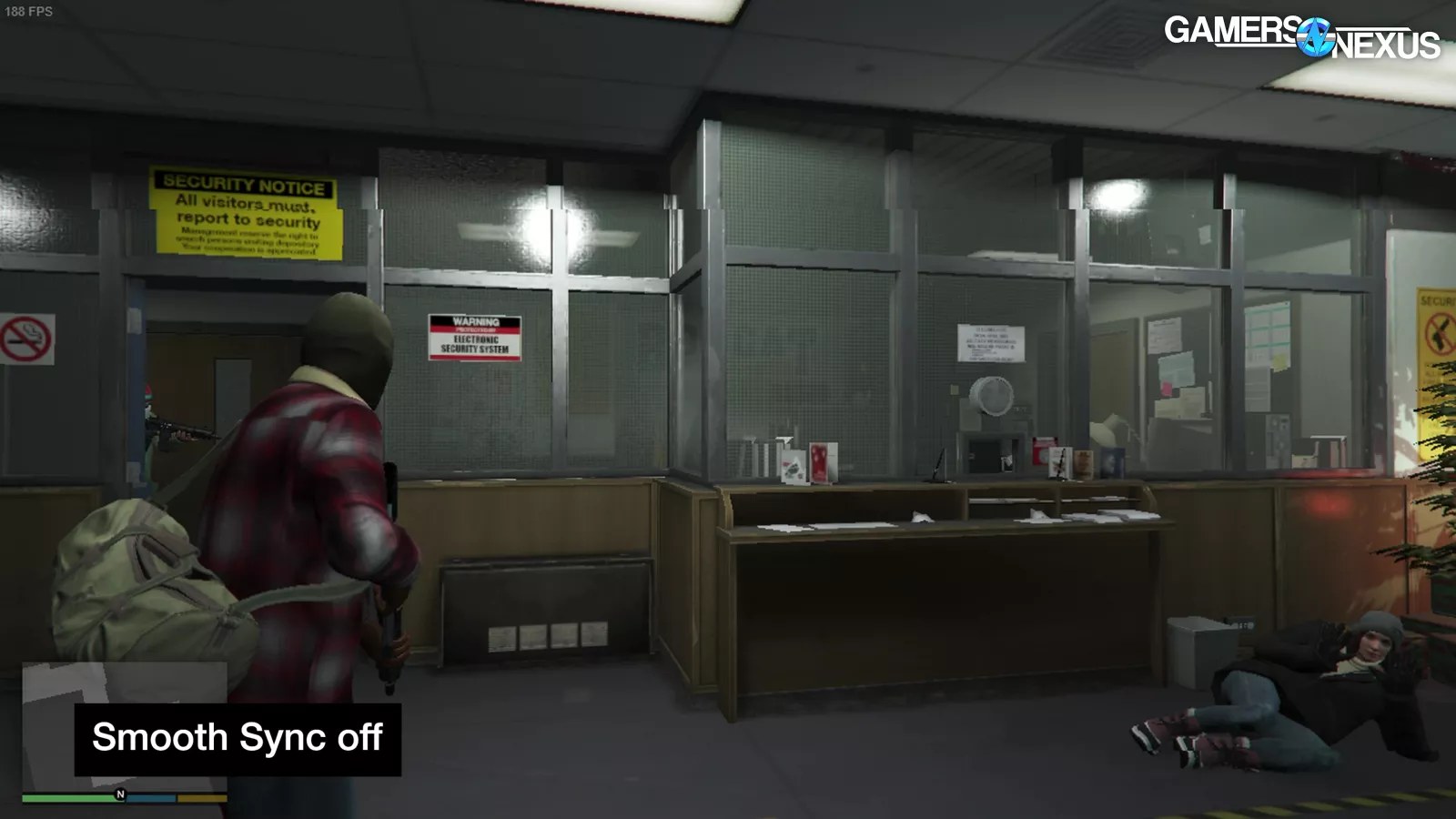
Those aren't lies per se, but we tried Smooth Sync again a couple months later, and the results made us suspicious. We confirmed those suspicions for this piece: Smooth Sync is simply turned off for Rainbow Six Siege and GTA V, and presumably any other games that had reported issues. It still works as expected in games that we originally saw it working in, like Strange Brigade, so at least 1 person will be happy, but then again, it also requires players to have an Intel Arc GPU, so that number may be closer to 0… As far as we know, Intel never copped to the fact that its "fix" was to just turn off Smooth Sync.
As for Speed Sync, it's just gone. There's no mention of it in the Arc Control menu. Rest in peace, Speed Sync. That’s one way to fix a bug. You can’t have bugs if you don’t have features.
Duplicate Control Panels
When Arc launched, not only would the Arc Control app be installed as part of the driver install process, but the Intel Graphics Command Center would also automatically download afterwards. That's not true anymore, which may be an improvement, but Command Center does offer different variable refresh settings than Arc Control does when a compatible display is connected.
Intel Arc Control contains these settings (all in separate sub menus):
- "Variable Refresh Rate: Provides a smoother gameplay experience by dynamically syncing your displays refresh rate with frames rendered by your graphics product [Enabled/Disabled]"
- "Variable Refresh Rate Mode: Changes the supported application modes for Variable Refresh Rate capable displays [Fullscreen & Windowed/Fullscreen/Disabled]."
- "Tearing Mitigation Modes: Select a frame display method for your application [Application Choice/VSync On/Smooth Sync/Smart VSync]"
Intel Graphics Command Center contains this setting:
- "Adaptive Sync: VESA Adaptive Sync feature: Enable Adaptive Sync to adapt the display's refresh rate to the GPU frame rate. To get the best experience, it is recommended to set the maximum refresh rate for the display. [On/Off]" (with subsettings for Unlock FPS and Adaptive Sync Plus)
And on top of that, Windows contains this setting:
- "Variable Refresh Rate: When possible, get a higher frame rate and reduce screen tearing in games that don't support variable refresh rate by default. You might need to restart your game for this to take effect [On/Off]."
None of these settings are linked to each other, except that VRR can't be enabled in Arc Control unless it's enabled in Graphics Command Center first, but not vice versa. It's just confusing, and there needs to at least be some explanation.
But Intel did remove the duplicated Smart VSync setting from Command Center, so someone's listening.
Intel Driver & Support Assistant
Intel's Driver & Support Assistant tool is still forcibly installed alongside Arc Control. You can install the bare driver, or you can install the driver and Arc Control AND the Assistant, but you can't install just the driver and Arc Control.
It's especially annoying for us, since we'd like to avoid installing auto-driver-update bloatware on vital test benches. Even though it's part of the GPU driver install, DSA isn't handled by Wagnardsoft's DDU cleanup like Arc Control and Graphics Command Center are, because it's a random piece of non-GPU-related software. DSA can be manually uninstalled immediately with no consequences.
HDCP
Next up is HDCP.
Because of how Smooth Sync works, we needed to use an external capture system to record it in action, and it was a massive pain. HDCP blocked us from recording anything. AMD includes an option in its control panel to explicitly disable HDCP, and although NVIDIA doesn't, we've successfully used this capture system with NVIDIA cards in the past.

In order to capture Intel, we had to use the old-school janky HDMI splitter workaround. HDCP is already annoying, and this is a poor implementation.
Intel Arc Notifications
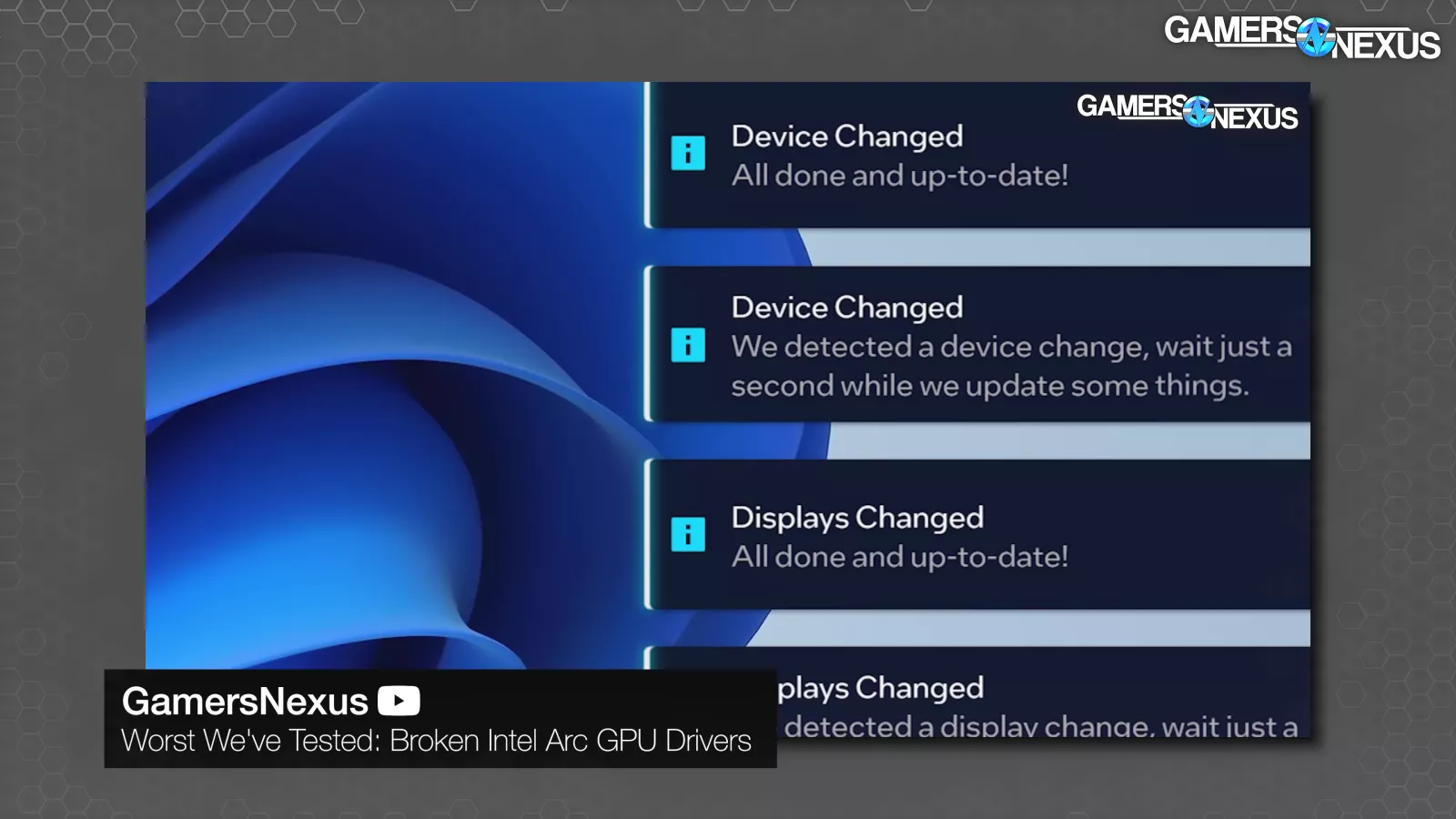
At launch, Intel blasted a ton of annoying notifications from the system tray that would pop-up with notes of varying usefulness.
Intel may have cut down on the number of notifications from Arc Control, but the ones that show up (before they're turned off) are still pretty annoying. The "toast" isn't delivered through Windows notifications, it comes from the app itself, and the notifications can't be interacted with or dismissed until they time out on their own. That’s the most annoying part. You have to sit there and stare at them until they go away. Also, the DPI scaling is screwed up on old 1280x1024 monitors.
But, despite the fact that we still find them useful, most people probably don’t. No big loss there.

Intel Arc Semi-Fixed Problems
Time to get into the problems that were at least partially resolved by Intel. This section is a mix of resolved and unresolved: It’s Schrodinger’s driver bug. Until you install the driver, it is both broken and not broken.
Intel Arc Monitor Compatibility

Monitor compatibility was one of the most serious complaints from our original batch. We saw issues with two different display types -- one new and one a high-end 4K display from 2014 -- where Intel struggled with display out despite competing cards working with both monitors.
At launch, the A380 completely failed to work with them. Later, during our A770 review, we found that Arc cards could output to those displays using updated drivers, but only after the driver loaded. That means no output in BIOS or Windows Safe Mode. We observed the same behavior on at least one other monitor in the office, but to be fair to Intel, we've seen a similar issue (as it stands now) with some non-Intel monitors and GPU combos.
If you're getting a black screen with a new Arc card, try swapping to another monitor to install the driver, then swapping back.
Intel Arc Fans
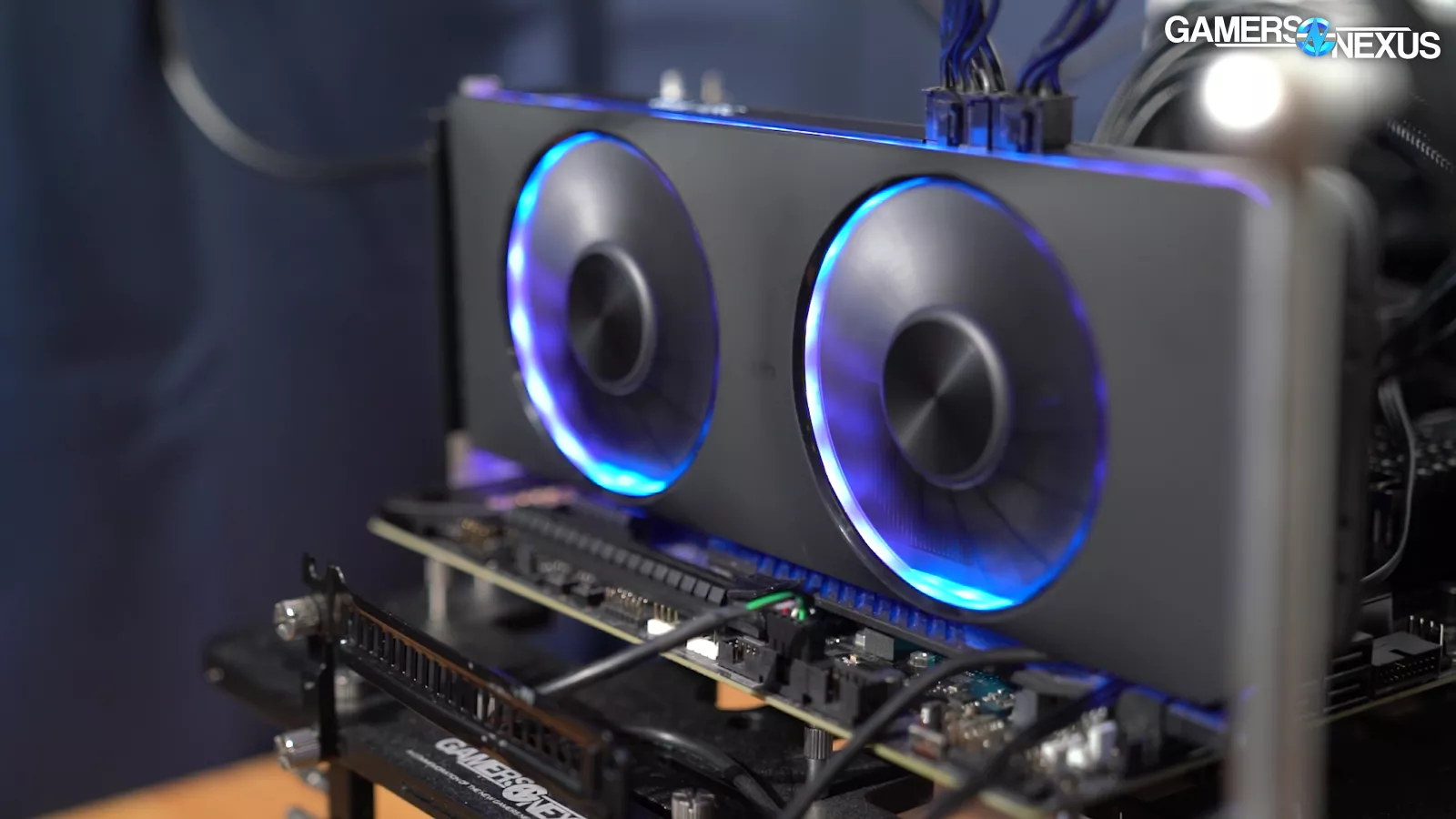
In our Arc A770 LE review, we saw the fans on our GPU spun constantly, never turning off even at idle. We have occasionally seen the fans spin down with updated drivers and firmware, but the heat generated (and power drawn) by the A770 LE at idle remains high enough to keep the fans spinning the majority of the time, so we're not counting this as a full fix.
Intel Arc Design Choices
Intel Arc Inherent API Issues
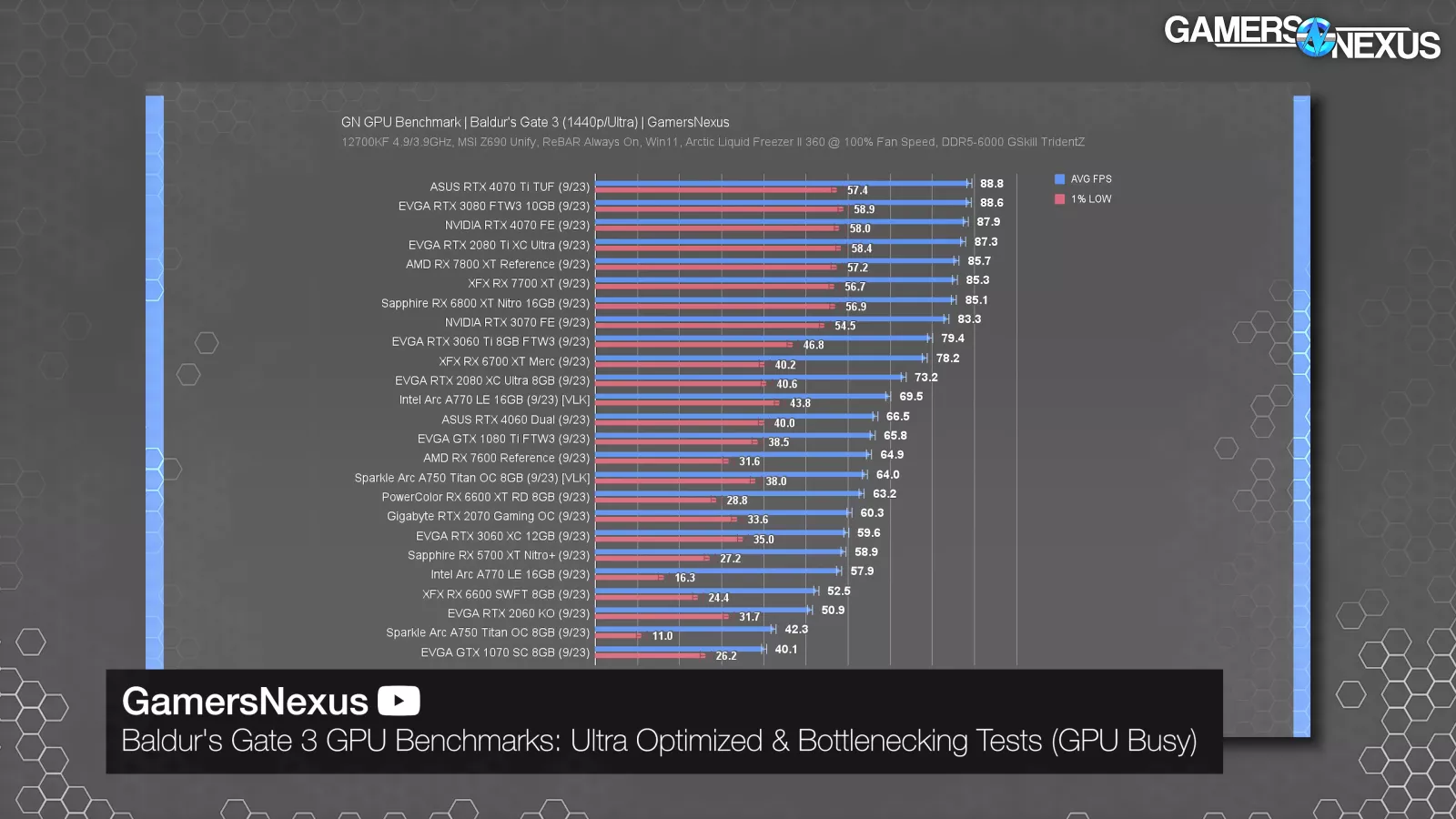
As a general rule, games don't run as well on Arc when using DX9 or DX11. That's in comparison to other vendors on DX9 or DX11, and to Arc cards using DX12 or Vulkan. As TAP said, "It's just going to be a labor of love for forever making DX11 titles get better and better and better, and DX9 as well."
DX12 and Vulkan are thin APIs that shift responsibility for memory management and optimization to applications (game engines), while previously DX11 and DX9 shifted responsibility to GPU drivers.
DX11 and DX9 create more work for GPU vendors, and NVIDIA and AMD have a head start, while Intel is stuck playing catch-up supporting software that's already on its way out.
This has contributed to Arc's subpar record for day-one game support, especially for DX11 games. If Intel were to slow or halt software support for Arc, game compatibility would likely rapidly go downhill.
Also, "for DX9, Intel uses a DX9on12 mapping layer." That means that Arc DX9 performance depends on the ongoing development and optimization of this layer.
We think Intel made the right choice by focusing its efforts on newer API support, but it means that Arc isn't a reliable platform for playing older games, which is unfortunate given the mid- to budget-range price and performance of the A-series cards. That was true at launch and remains true now: Although support has significantly improved, it will be a continual, ongoing effort to update games on older APIs (whether or not those games are new). Baldur’s Gate was an easy, recent example, although its Vulkan option gives Arc users an alternative.
ReBAR
This one wasn’t an issue. It was a design choice: Arc needs ReBAR. It works without ReBAR enabled, but performance can be massively worse depending on the application. This issue is inherent to the memory controller used by Intel. Intel's memory controller doesn't perform well with small transactions; it prefers the large transactions enabled by ReBAR. Again, this is an area where we think Intel compromised well by focusing on newer platforms, which usually support ReBAR and enable it by default. It may hurt Arc's ability to fit in the ultra-budget space, though, since old hardware is less likely to support ReBAR.
That’s all still true now. But again, we think you should be enabling ReBAR on everything these days unless you have a very specific use case.
Intel Arc Fixed Problems
Windows Driver Update
Now we’ll move to the fixes and the positive side.
On a more positive note, there are many issues that have been fully solved. One in particular that we're cautiously optimistic about is Windows Update repeatedly overwriting driver installs.
Formerly, if you installed Intel drivers with "clean install" selected (especially after running DDU), Windows Update would immediately downgrade the driver to whatever ancient LTS version it had on hand. Intel's official recommendation back then was to "make sure not to enable the Execute a clean installation check box," which is completely unacceptable as a fix.
We can't promise that this problem is gone permanently, but we tried a clean install on our test bench and Windows Update left us alone. That’s a good thing.
Intel Arc Miscellaneous Fixes
Many of the other complaints that we called out have simply been resolved, with no further discussion needed. But we do want to list them and give acknowledgement and credit. For perspective, here are some of the things that Intel has crossed off its list over the past year:
Fixed: Rainbow Six
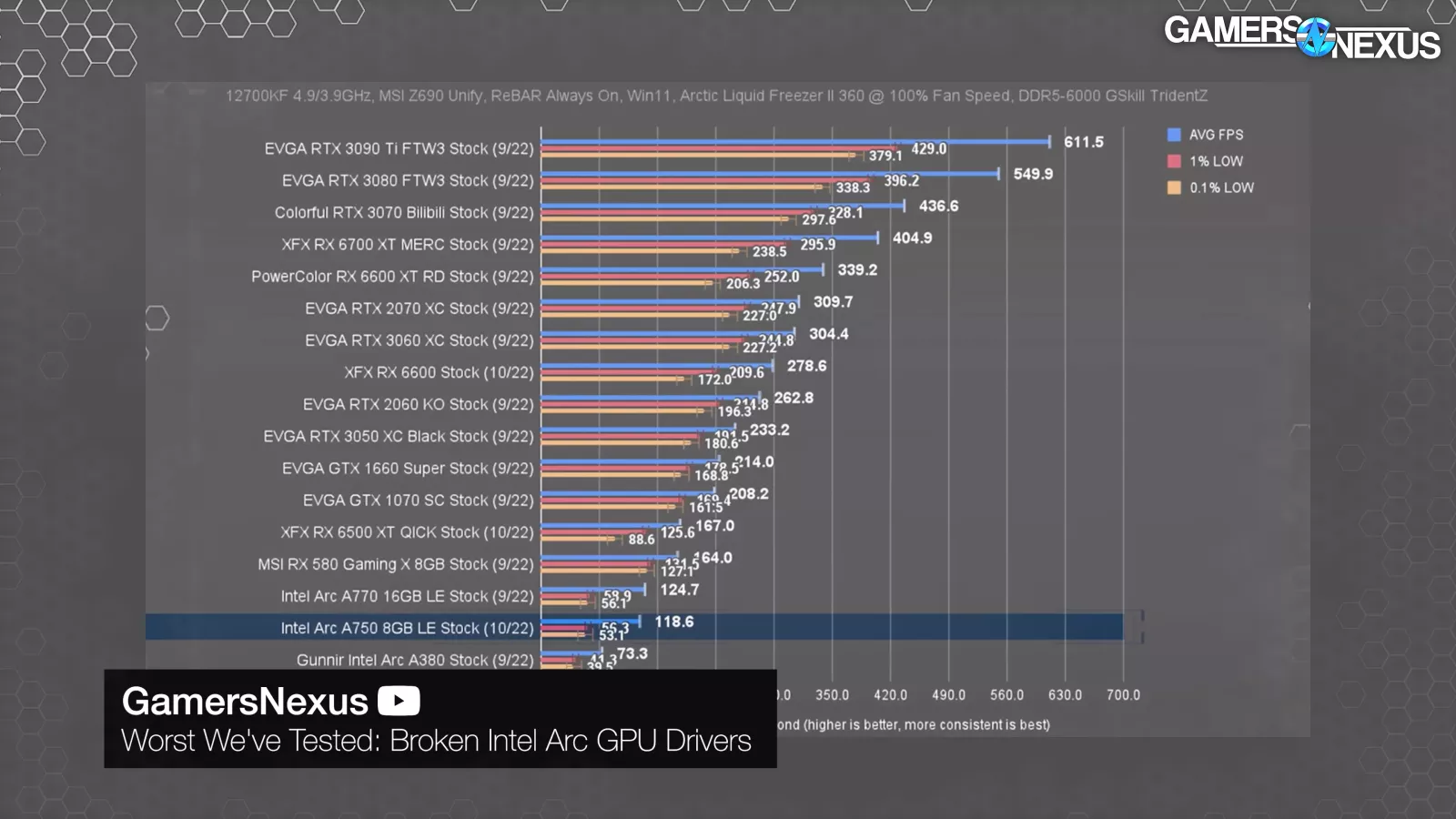
We covered Intel’s severely bugged Rainbow Six Siege behavior previously. The game was wildly inconsistent on Arc, where frametimes would sporadically double, or in other words, the framerate would sporadically halve.

Intel resolved this issue when we covered it back in February of this year. The net result was a significant improvement to the frametimes and the average framerate.
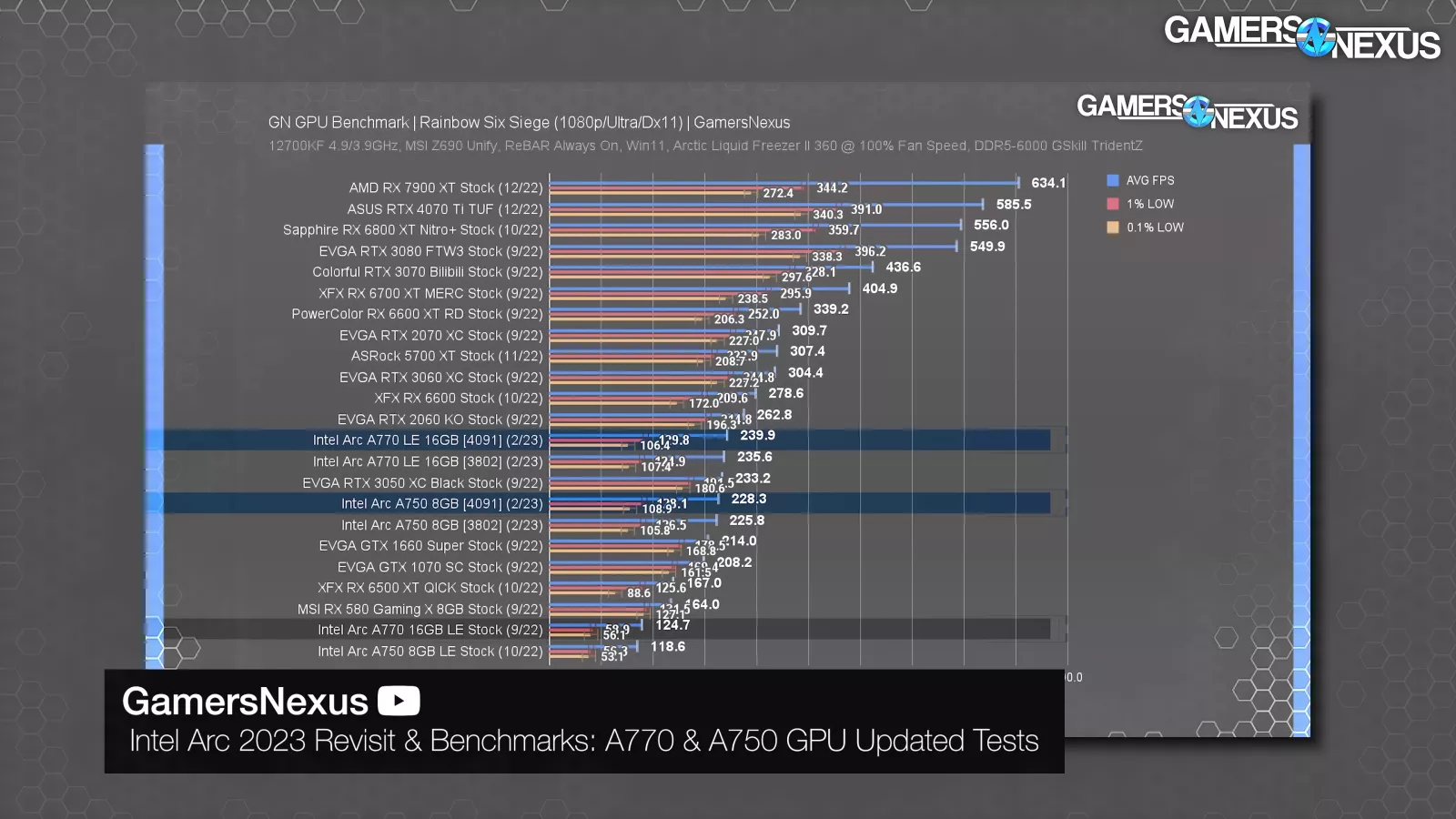
In this chart from our original coverage of the fix, you can see that the A770 and A750 went from the bottom of the chart toward the middle. That’s a big uplift.
Fixed: CSGO Performance
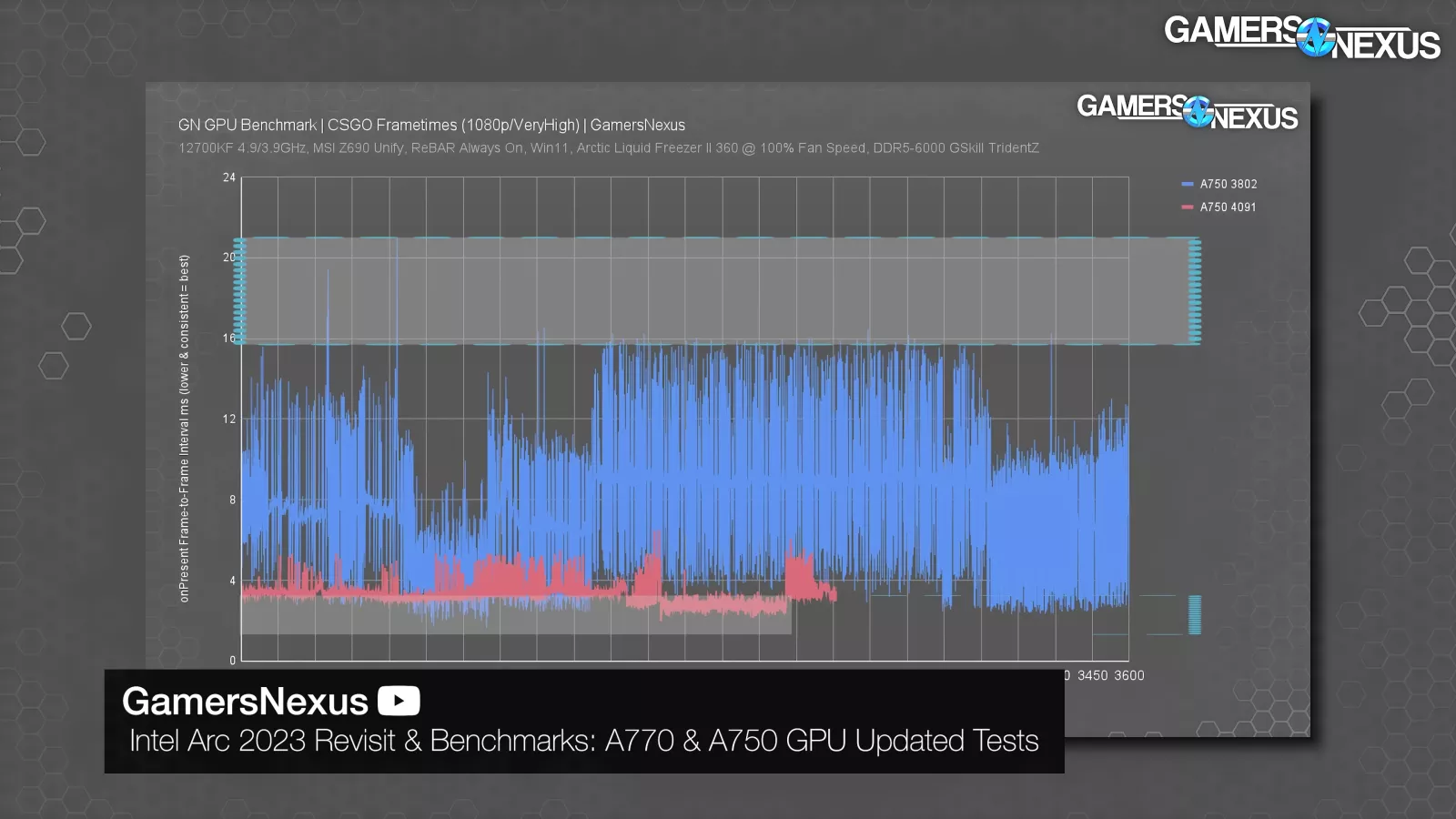
As we mentioned, before CS2 replaced it, CSGO’s bugged performance was also resolved. The frametimes were some of the worst consistency we’d seen in a long time, and Intel fixed that early this year. The game has since been replaced, but the groundwork for the fix remains in the drivers.
Fixed: Arc Control Overlay
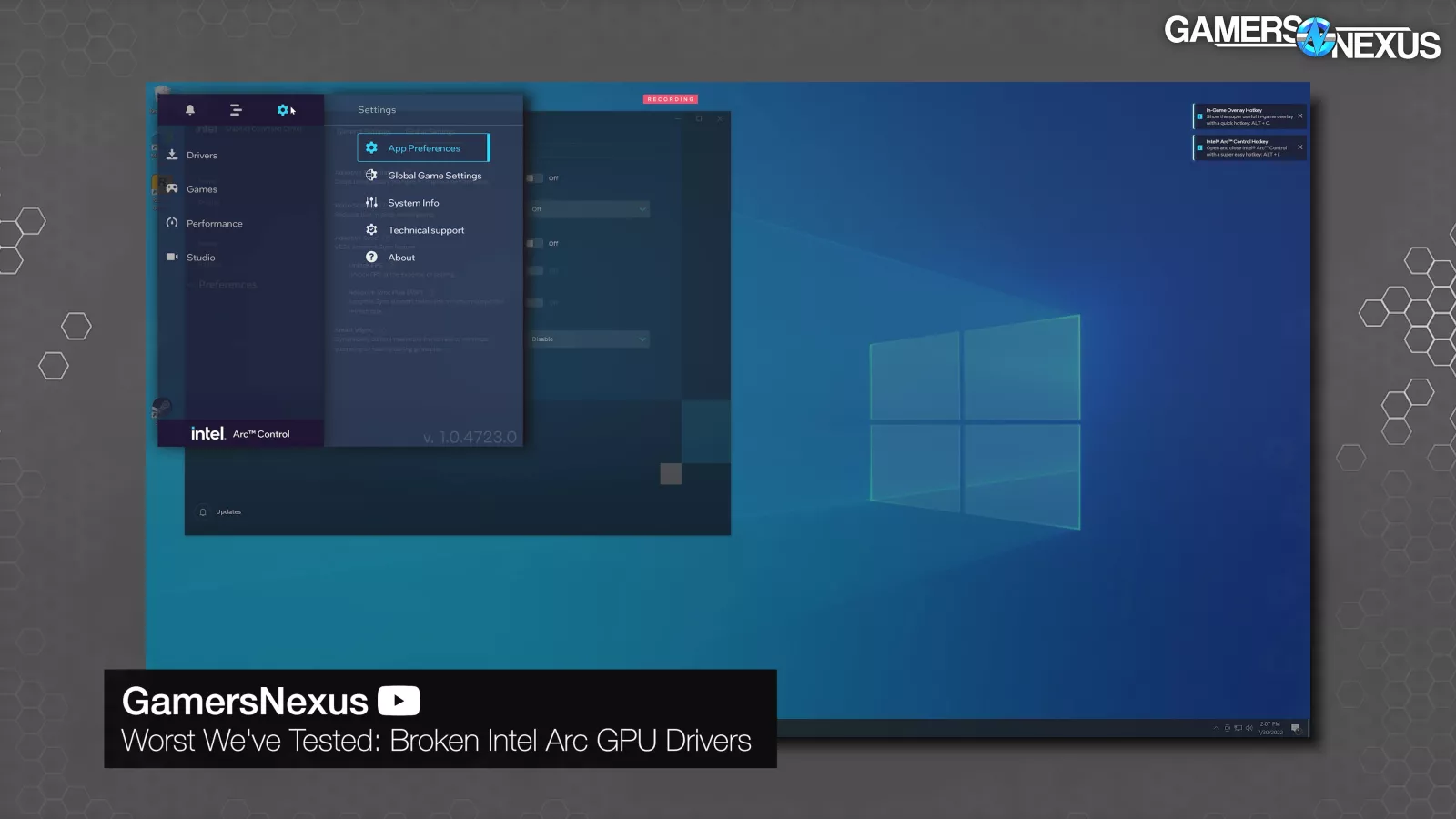
One of the big ones was Arc Control’s existence only as an overlay. This was incredibly frustrating: Arc Control would act as if it were a Steam overlay, making it impossible to interact with the rest of the desktop. This overlay behavior persisted even when it was the only application open. Rather than being a window, you’d have to alt-tab out of it to access other applications (including notepad). This was a big UX oversight. Intel has fixed this behavior and greatly improved usability as a result. We’re happy to see this improvement.
Fixed: Broken Arc Control Center
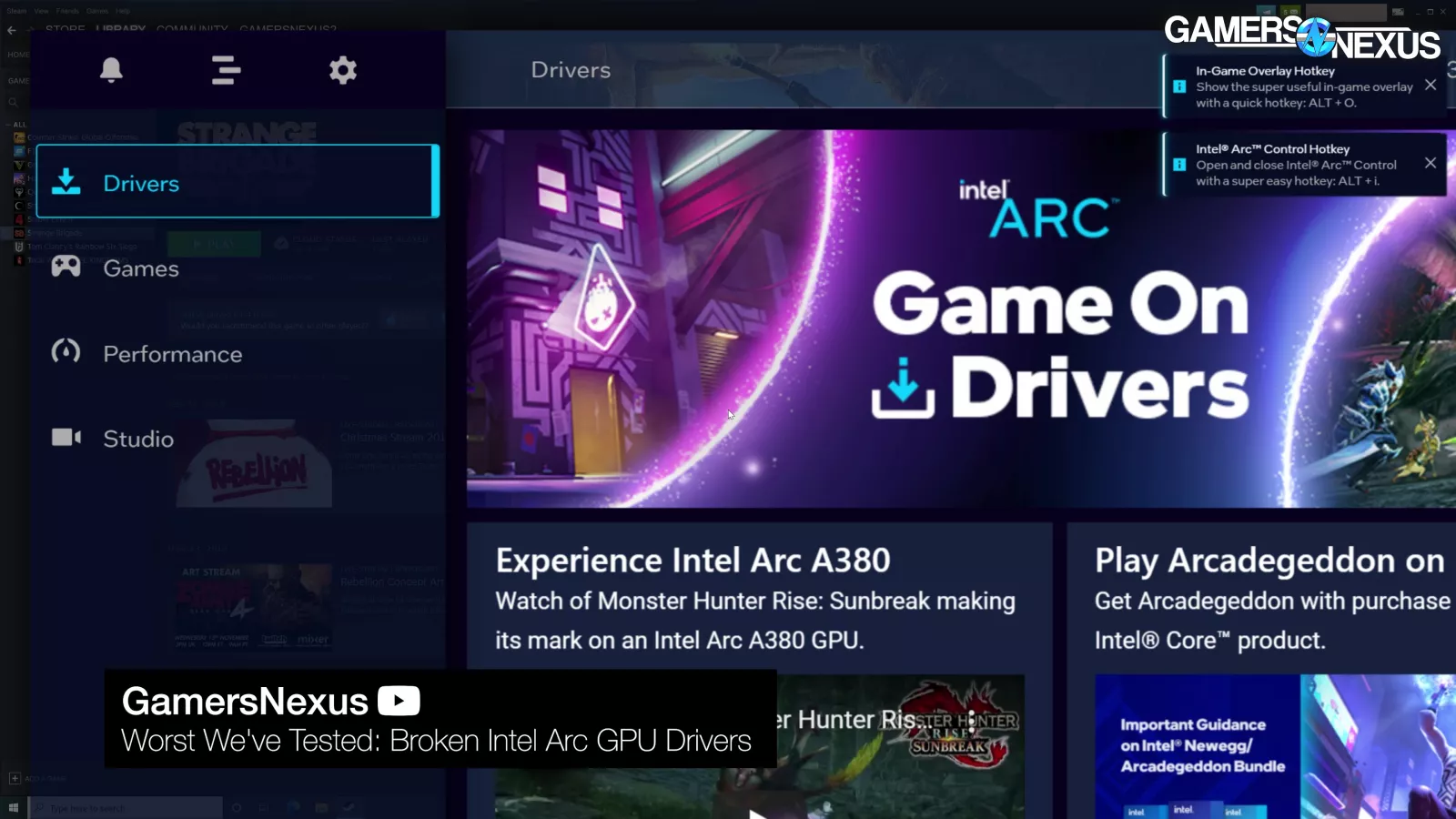
Another one was a fix to the Arc Control Center. Previously, this series of actions would completely break the overlay: Opening the Arc Control overlay in a lower-res application (e.g. 1080p) on a higher-res display (e.g. 4K), then exiting, then opening the overlay on the native-res desktop. This specific problem has been fixed.
Fixed: Notification Behavior on Wake
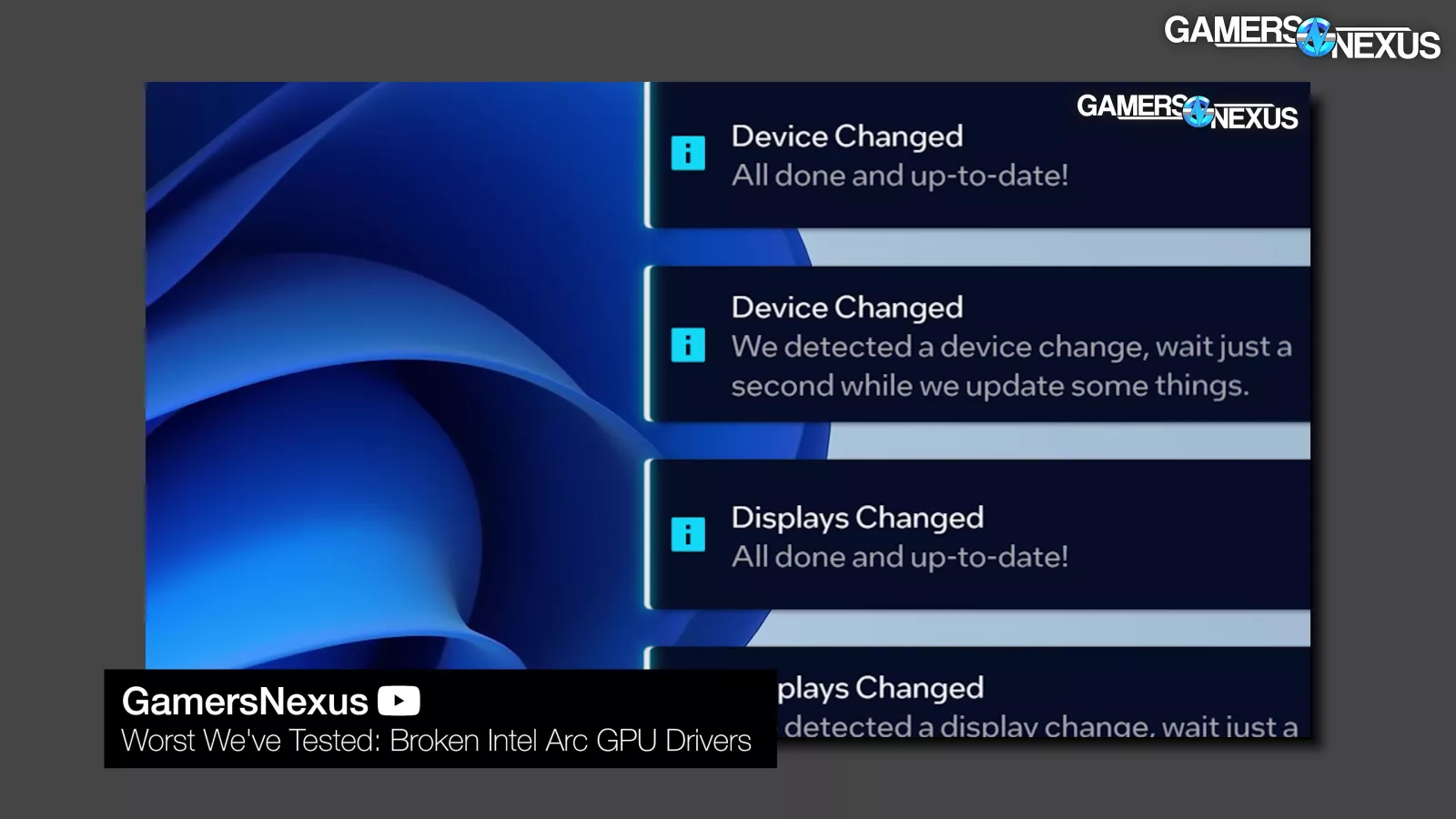
We complained heavily about the non-dismissible notifications. Some of these annoying behaviors still exist, but one critical one has been resolved: On display wake, not even system wake, Control used to pop-up multiple notifications every single time the display woke up. This was particularly annoying because they could not be dismissed. Intel has resolved this on our test monitors, at least.
Fixed: ReBAR Support Error
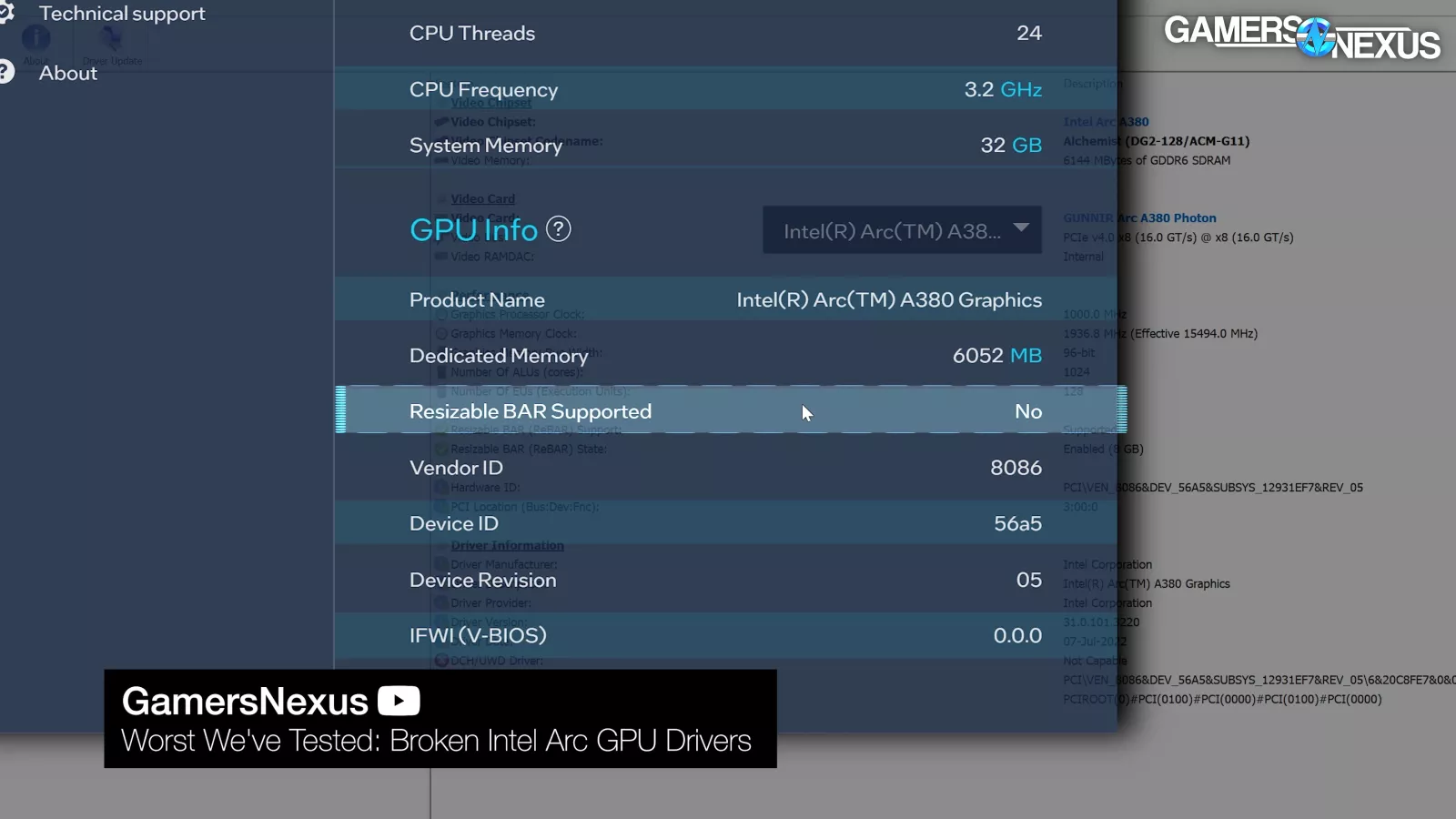
ReBAR was previously incorrectly listed as not supported in Arc Control even when it's enabled and working. This has been resolved. We have not seen this issue again.
Fixed: Driver Installation Required Internet
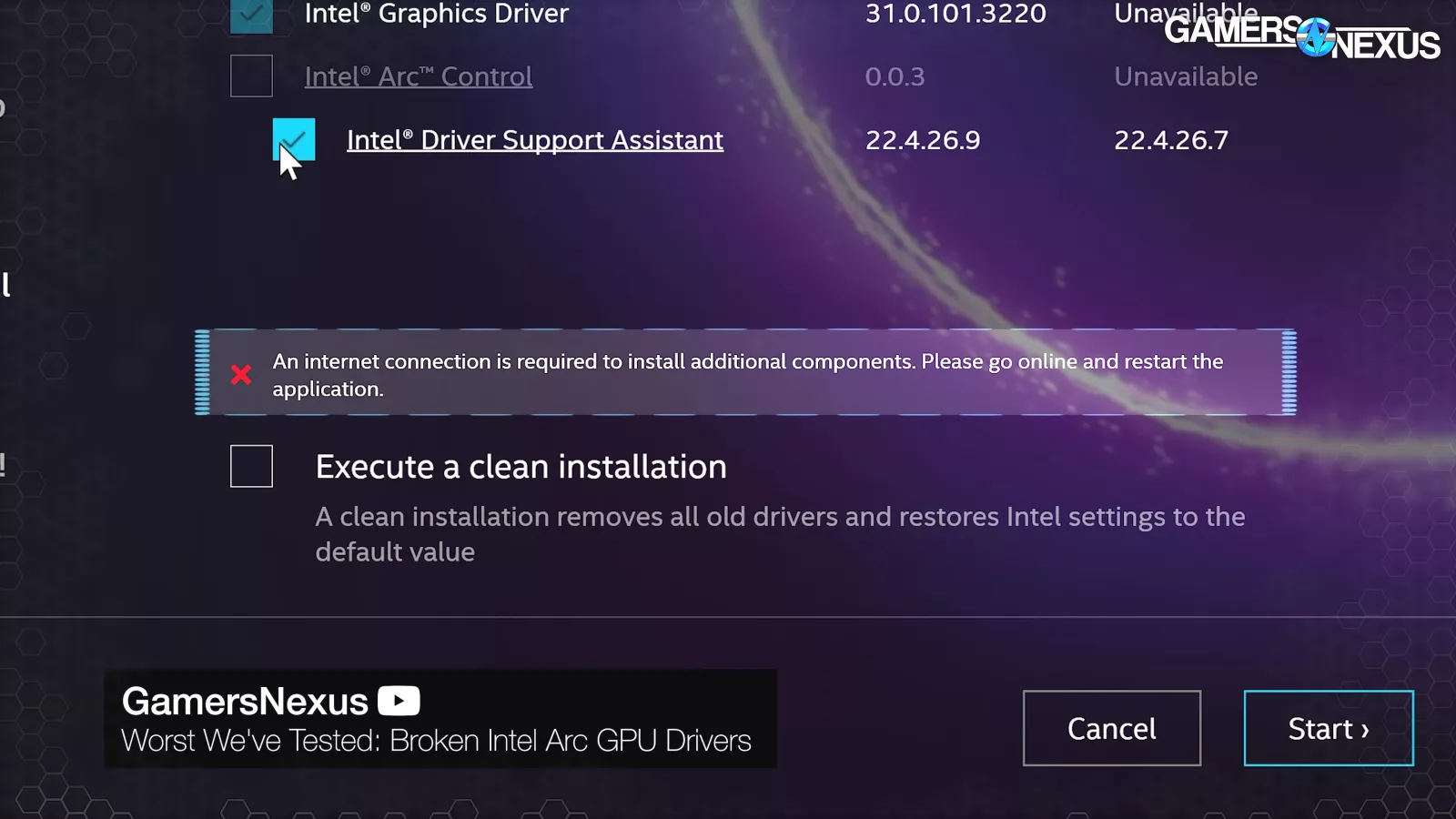
This was another big oversight: Driver installation weirdly required an internet connection. This was a big issue because Windows could take over and hijack the install and install an older driver version prior to the user completing their own install. This has been resolved.
Fixed: Driver Installer Minimized & Can’t Restore
This was a small one. The driver installer would previously minimize itself during install and would not restore. This was resolved.
Fixed: Driver Package Repair

Previously, rerunning the driver package installer would only give the option to repair the current install, without options to change what features are installed or reinstalled. Intel has improved this behavior.
Fixed: Resetting Overclocks Throws Error
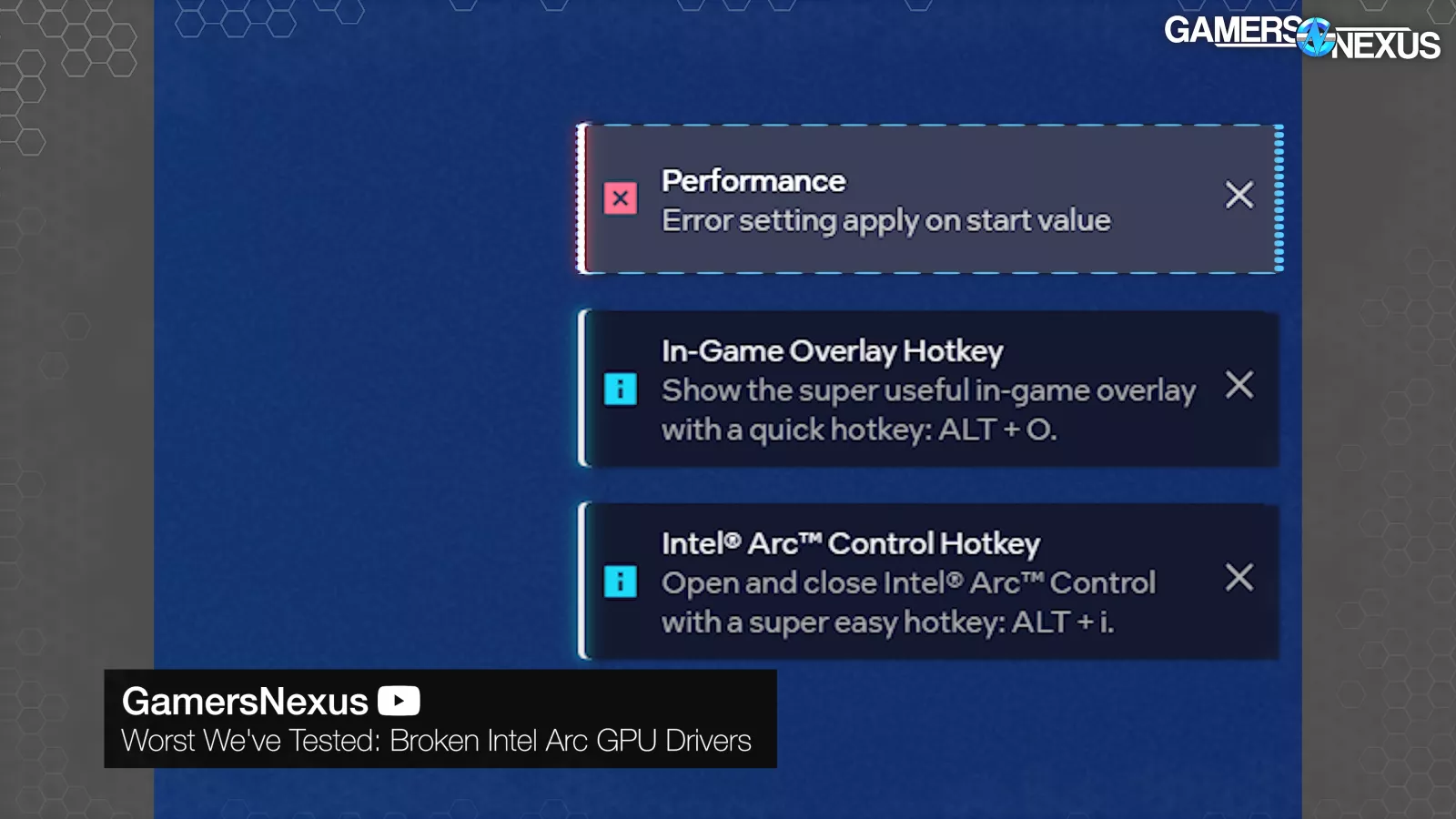
Another fix: Previously, using the “reset” button on the overclock screen to reset OC values would throw an unexpected error, as if no one had ever used that page before shipping. Intel fixed this following our review.
Fixed: Performance Slider Errors, mV Errors, Fan Control
The next is a series of fixes for performance slider changes, voltage control, and fan control. Previously, the performance slider would throw errors when adjusted. That’s fixed. Also, the voltage control was oddly in decimal mV, so microvolts instead of millivolts. The changes either didn’t actually do anything because they were too small or it just presented improperly. Also fixed. And finally, fan control did not work or exist. That appears to be mostly fixed.
Fixed: Arc Control Inevitably Breaking, Instancing, & Launch Issues
There was another issue where Intel Arc Control would just inevitably break. We didn’t have any explanation for it, but with 100% consistency, it would stop working on all systems. After this happened, it couldn’t be reinstalled on that system AT ALL. It was a critical fault. We actually nuked an OS over it. That’s been fixed.
Additionally but related, Arc Control would open multiple instances at times -- for reasons also unknown to us. It’d also sometimes just fail to install for seemingly no reason.
Finally, Intel DSA would report an update available for Arc Control, but trying to download it permanently broke DSA. This appears to be fixed.
Intel Arc Conclusion

Overall, Intel Arc software has improved dramatically but remains a largely manual effort. The hardware has always been good when it works.
We are concerned about Intel’s driver team after the company’s recent round of layoffs, as this manual effort means a high manpower requirement.
Arc has been a strong value recently, especially the A750, and for it to move from a recommendation of “this is good for patient enthusiasts with troubleshooting experience” to “this is good to recommend to your family member for whom you don’t want to provide tech support,” they’ll need to continue improving the day-1 support for games. There are still multiple games that we’ve tested like Starfield and GTA V that have been broken at various times.
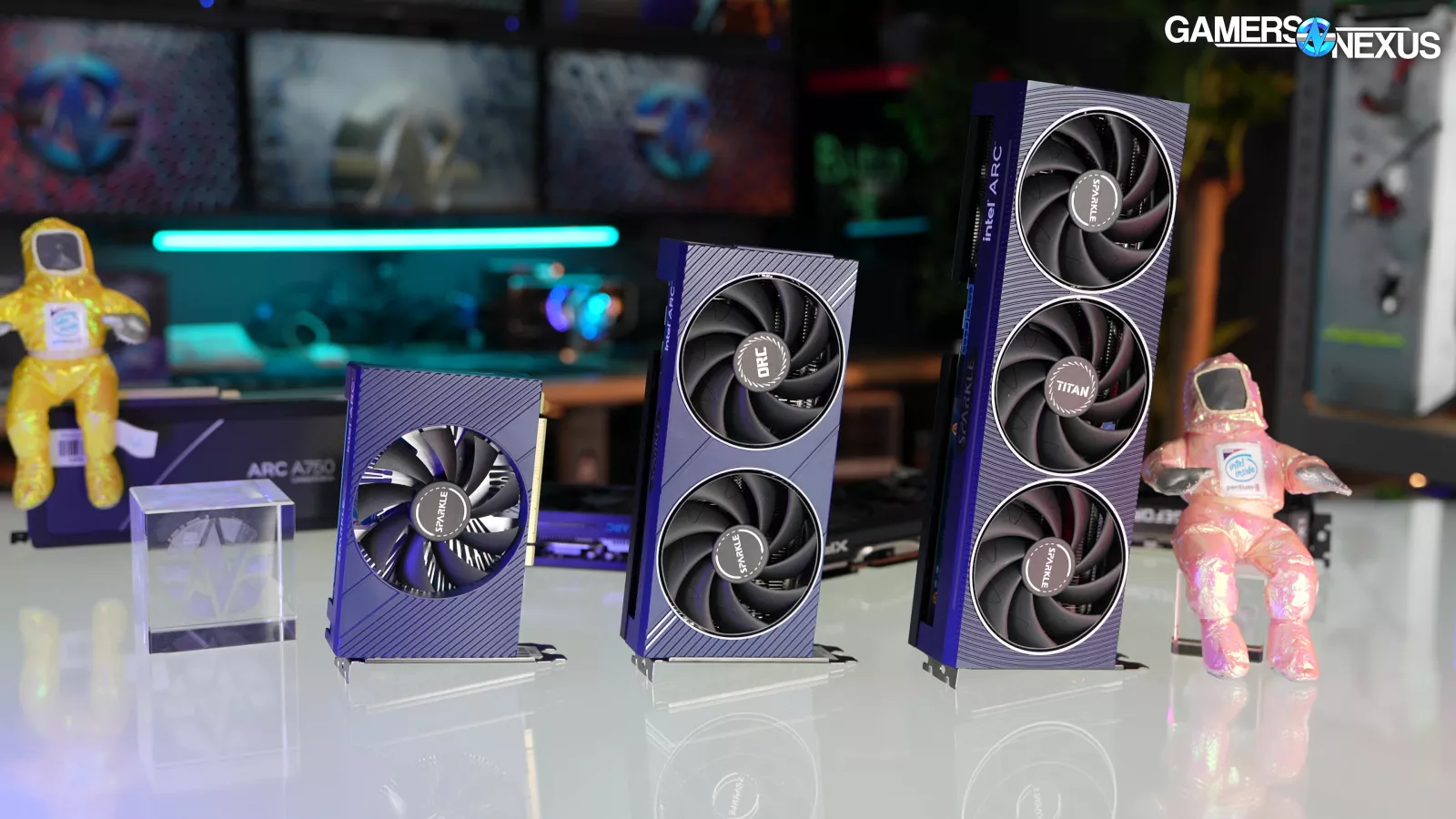
But overall, Intel has in fact resolved many issues. Some of the remaining ones are disruptive for casual users (or users without a second GPU, or users who are playing brand new games right when they launch), but at least the drivers are moving in the right direction.

